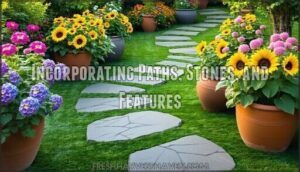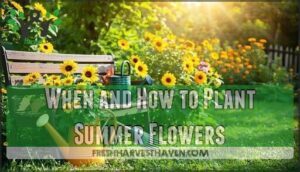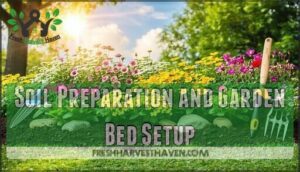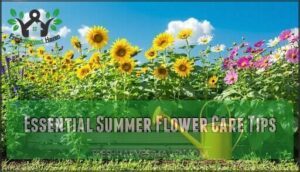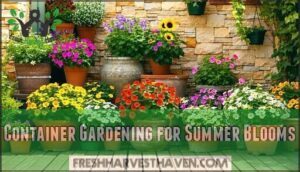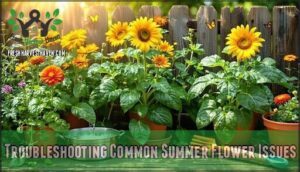This site is supported by our readers. We may earn a commission, at no cost to you, if you purchase through links.

Summer flowers demand different timing, deeper watering schedules, and strategic placement that accounts for midday sun intensity—skip these adjustments, and even drought-tolerant varieties will wilt by July.
This guide walks you through each decision point, from selecting varieties that actually thrive in heat to troubleshooting the wilting and fungal issues that crop up when temperatures spike.
Table Of Contents
- Key Takeaways
- Summer Flower Basics and Planning
- Selecting The Best Summer Flowers
- Designing Your Summer Flower Garden
- When and How to Plant Summer Flowers
- Soil Preparation and Garden Bed Setup
- Essential Summer Flower Care Tips
- Container Gardening for Summer Blooms
- Troubleshooting Common Summer Flower Issues
- Frequently Asked Questions (FAQs)
- What is the 3 year rule in gardening?
- Is September too late to plant flowers?
- Can container flowers survive extreme summer temperatures?
- How do you transplant summer flowers mid-season?
- What companion plants work best with summer flowers?
- Should you fertilize flowers during drought conditions?
- How do I fertilize summer flowers properly?
- What are the best companion plants combinations?
- How do I overwinter tender perennials?
- When should I divide established perennial clumps?
- Conclusion
Key Takeaways
- Summer flowers fail primarily from poor planting execution rather than variety selection—most losses stem from ignoring heat-specific watering depths, timing adjustments, and sun placement strategies that spring perennials don’t require.
- Successful summer bloom timing depends on frost tolerance classifications: hardy annuals tolerate 32–45°F and plant two weeks before last frost, while tender varieties need 60°F soil and consistent 55°F air temps with zero frost risk.
- Deep watering in early morning at root zones beats frequent shallow watering—most drought-resistant varieties don’t need daily drinks, and drip irrigation systems deliver better water conservation than overhead methods that invite fungal disease.
- Container success requires engineered potting mix with perlite or vermiculite for drainage and aeration, not garden dirt—combined with heat-tolerant compact varieties and twice-daily watering during peak heat to prevent root suffocation.
Summer Flower Basics and Planning
Before you start planting, you need to know what you’re working with and what thrives in your climate. Understanding the difference between annuals and perennials, how to mix colors and heights for visual impact, and which growing zone you’re in will set you up for success.
Here’s what you need to nail down first.
Annuals Vs. Perennials
If you’re planning a summer garden that laughs in the face of heat and thirst, you’ll want to know the difference between annuals and perennials—because choosing the right one can make or break your blooming season.
Annuals sprout, bloom, and go to seed all in one season, giving you non-stop color but requiring replanting each year.
Perennials, on the other hand, return for two or more years, though their first-year blooms might be sparse while roots get established.
Choosing Colors, Heights, and Textures
Once you know whether you’re planting for one season or the long haul, the real fun begins—layering colors, heights, and textures to turn your garden from flat to extraordinary.
Place taller blooms like delphiniums in the back of flower beds, medium varieties in the center, and ground covers up front to create garden layers that draw the eye through. Mix spiky textures with rounded blooms and weave together color schemes that shift from cool to warm for maximum impact.
Understanding Growing Zones
Before you fall in love with any flower’s color or shape, you’ll need to figure out if it can actually survive in your neck of the woods—and that’s where understanding your growing zone comes in. Zone mapping breaks down climate types and temperature ranges across regions, giving you the real story on what’ll thrive versus what’ll struggle. Here’s what understanding growing zones tells you:
- Which plant varieties can tolerate your winter lows and summer blooms
- Regional gardening tips specific to your soil classification
- Temperature ranges that determine your planting calendar
Most Northeast gardeners work with zones 3 to 7, which shapes everything from timing to plant selection.
Selecting The Best Summer Flowers
Not all flowers laugh in the face of summer’s worst heat—so your choice matters more than you think. The right varieties will bloom longer, need less babysitting, and turn your garden into a magnet for butterflies and bees.
Here’s how to pick summer flowers that actually thrive when the mercury climbs.
Long-Lasting Bloom Varieties
You’ll want performers that go the distance—zinnias and coreopsis can bloom for four to five months straight, from late spring until the first frost claims them. These summer flowers deliver serious flower longevity, with coreopsis maintaining blooms for up to 100 consecutive days.
Stella de Oro daylilies generate fresh buds daily throughout their five-month run, producing up to 400 blossoms per season, while wax begonias hold their color for 180 days with minimal fuss.
These longlasting bloom varieties keep your garden vibrant without constant replanting. To guarantee continuous color, consider planting perennial flower varieties.
Heat- and Drought-Resistant Flowers
When summer heat cranks up, drought-resistant flowers like yarrow and blanket flower don’t just survive—they thrive with minimal water, needing only an inch weekly once established. These heat-resistant perennial flowers deliver water efficiency while keeping summer blooms alive through 90°F days and prolonged dry spells.
- Moss rose persists in full sun with less than half an inch of water per week
- Butterfly bush maintains bloom rates above 90% even when rainfall drops below an inch monthly
- Wax begonia stays viable when soil moisture dips below 10%, showcasing outstanding soil resilience and flower adaptation
For ideal results, gardeners should choose plants with heat tolerant traits.
Pollinator-Friendly Choices
Pollinator gardens draw essential visitors—bees, butterflies, and other beneficial insects—to your summer flowers through strategic floral diversity that strengthens local ecosystems.
You’ll optimize bee-friendly results by selecting butterfly plants like coneflower, black-eyed Susan, and zinnia, which provide abundant nectar throughout the season.
These pollinator-friendly gardens improve flower gardening while supporting biodiversity, creating a pollinator garden that feeds wildlife and boosts bloom production simultaneously.
Designing Your Summer Flower Garden
A killer summer garden isn’t just about tossing flowers in the ground and hoping for the best. The way you arrange plants, from their heights to their habits, can transform a flat bed into a living landscape that keeps delivering all season long.
Let’s break down how to layer your annuals and perennials, work with what you’ve got, and add those finishing touches that make your garden feel like yours.
Mixing Annuals and Perennials
If you’re looking to pack your garden with nonstop color from May straight through to the first hard freeze, mixing annuals and perennials is the smartest move you can make. Perennials bring back reliable blooms year after year, while annuals fill gaps and keep flower bed design vibrant when your perennials take a breather.
This combo gives you killer bloom timing, lets you play with garden texture and color harmony all season, and works beautifully whether you’re filling borders or trying container gardening.
Layering Plants for Depth
Think of layering like building a live stage—the tallest bloomers anchor the back, mid-height flowers carry the show in the middle, and low growers spill forward to frame the whole display with depth and drama.
You’ll create visual interest by mixing plant height variation—like stacking delphiniums behind daisies, then edging with creeping petunias.
This dimensional design trick works whether you’re plotting layered landscapes in beds or experimenting with container gardening using perennial flower options at different heights.
Incorporating Paths, Stones, and Features
Paths aren’t just functional walkways—they’re invitations that guide visitors through your garden while breaking up large beds into intentional viewing zones where each cluster of blooms gets its moment.
Toss in some stone selection for edging, a seating area tucked near your showstoppers, or outdoor lighting that highlights your garden landscape after dark—you’ll transform simple yard design into outdoor decor with real personality.
When and How to Plant Summer Flowers
Getting your timing right makes all the difference when you’re planting summer blooms. Most annuals and perennials won’t forgive an early frost, so you’ll need to know when to start seeds indoors, when to transplant, and how to manage bulbs that flower in summer.
Here’s what you need to get your garden off to a strong start.
Timing for Annuals and Perennials
Timing your planting schedule right is like catching the perfect wave—you’ve got to know when conditions align. The ideal window for summer flower blooms depends on whether you’re working with annuals or perennials, and your local frost dates will determine everything.
Here’s your planting schedule breakdown:
- Hardy annuals (pansies, snapdragons, alyssum) can tolerate the cold and go in two weeks before your last spring frost, tolerating temps down to 32–45°F.
- Tender annuals (zinnias, impatiens, coleus) need soil above 60°F and air temps consistently hitting 55°F—plant only after frost danger passes completely.
- Half-hardy annuals (marigolds, petunias) split the difference, going in when nights stay above 35–45°F.
- Summer-blooming perennials thrive when planted in early spring, giving roots 12–16 weeks to establish before peak bloom.
- Fall-blooming perennials need late summer or early fall planting, with at least six weeks before the first frost hits.
In northern zones (3–5), your window opens late April through May. Southern gardeners in zones 8–11 can start as early as March, giving you a serious head start on Summer Garden Design.
Starting Seeds Vs. Transplants
Once you’ve locked down your planting schedule, you’ll need to decide whether you want to start from scratch with seeds or fast-track your garden with transplants. Here’s what each method brings to the table:
| Factor | Seeds | Transplants |
|---|---|---|
| Cost | Pennies per plant | $3–$8 per plant |
| Time to Bloom | 6–10 weeks | 2–4 weeks |
| Variety Selection | Hundreds of options | Limited to what’s stocked |
| Skill Level | Needs attention to seedling care | Beginner-friendly |
| Risk | Germination failures happen | Transplant shock possible |
Seeds give you control over soil quality and growth rates from day one, while transplants deliver instant summer flower blooms without the seed-starting hassle.
Planting Bulbs for Summer Blooms
Summer-blooming bulbs like dahlias, gladiolus, and lilies don’t follow the same playbook as seeds or transplants—you’ll plant them directly in the ground in spring, and they’ll reward you with knockout color by midsummer. Here’s your bulb-planting cheat sheet:
- Timing matters for summer blooms: Plant bulbs after your last frost, when soil temps hit 55°F or warmer.
- Depth and spacing ensure heat tolerance: Dig holes 4–6 inches deep, spacing bulbs 6–12 inches apart for airflow.
- Prep for bulb division later: Mark locations now so you can divide crowded clumps next spring.
- Store extras properly: Keep unplanted bulbs in cool, dry spots until summer gardening begins.
Soil Preparation and Garden Bed Setup
Getting your soil right is like laying the foundation for a house—you can’t build something beautiful without it. Before you toss those summer flowers into the ground, you’ll need to know what you’re working with and how to make it better.
Here’s what you need to tackle: testing and amending your soil, nailing the right pH and drainage, and figuring out how to space your plants so they actually have room to thrive.
Testing and Amending Soil
Before you plant a single stem, you’ll want to know what’s actually going on beneath the surface—and a simple soil test is your backstage pass to what your garden really needs.
Pick up a kit from your local garden center to check nutrient analysis and pH levels, then amend based on results—compost boosts soil composition and aeration, while organic fertilizer types fill nutritional gaps for ideal plant care.
Ideal Soil PH and Drainage
Most summer flowers hit their ideal range between a pH of 6.0 and 7.0—slightly acidic to neutral—but master the drainage first, because even perfect pH won’t save roots sitting in waterlogged soil.
Mix in coarse sand or perlite to boost soil aeration, and consider raised beds if water retention becomes a persistent problem—proper soil conditions surpass fancy fertilizers every time regarding healthy plant care and vibrant blooms.
Spacing and Positioning Plants
Give each plant enough breathing room to spread its roots and foliage without crowding its neighbors—cramped conditions invite disease, weak stems, and a scramble for water that nobody wins.
Check mature plant heights and growth patterns before you dig, then map out your garden with spatial planning that accounts for sunlight requirements—tall bloomers belong in back, low-growers up front, with spacing that lets air circulate freely through every layer.
Essential Summer Flower Care Tips
Getting your flowers through the summer heat takes more than just crossing your fingers and hoping for the best. The right care routine keeps blooms coming strong when temperatures climb and rainfall gets scarce.
Here’s how to water smart, protect your soil, and keep those plants looking fresh all season long.
Watering Strategies for Heat
When the heat cranks up, your watering schedule can make or break your summer blooms—and most gardeners get it wrong by watering too often at the wrong times. Here’s how to keep your flowers thriving without wasting water:
- Water deeply in early morning to minimize heat stress and optimize soil moisture absorption
- Install drip irrigation systems for consistent water conservation and drought tolerance
- Check soil moisture 2-3 inches down before watering—most drought resistant varieties don’t need daily drinks
- Focus water at root zones during summer gardening, not on foliage, for better garden maintenance
Mulching and Weed Prevention
A two-inch blanket of organic mulch around your summer flowers isn’t just pretty—it’s your frontline defense against weeds that steal nutrients and moisture your blooms desperately need in the heat.
Use shredded bark or compost as your weed barrier to keep soil temperature stable and boost plant growth.
Apply it right after soil preparation, leaving space around stems to prevent rot—smart garden maintenance beats hours of pulling weeds later.
Deadheading and Pruning
Snipping off spent blooms—deadheading—tricks your plants into producing more flowers instead of going to seed, turning a decent summer display into an all-season show. Grab clean pruning tools and cut just above the next bud for precise stem cutting that encourages plant renewal.
For bushier growth and flower shaping during the blooming season, don’t skip light pruning—these simple summer gardening moves keep your flower care game strong all season long.
Container Gardening for Summer Blooms
Container gardens let you pack summer color into tight spaces, experiment with bold combinations, and move your blooms wherever they’ll shine brightest. You’ll want flowers that don’t mind a bit of confinement, soil that drains like a dream, and a setup that’s as easy to maintain as it’s to admire.
Here’s how to fill your pots with blooms that’ll stand up to the heat and keep turning heads all season.
Best Flowers for Pots and Planters
If you’re working with limited space or want the flexibility to shuffle your summer blooms around, container gardening lets you break free from traditional bed layouts and bring vibrant color right onto your patio, balcony, or doorstep.
Heat-loving annual flowers thrive in pots and planters when you choose compact, bushy varieties:
- Zinnias and petunias tolerate full sun without wilting
- Begonias and impatiens brighten shaded corners
- Geraniums and marigolds deliver nonstop color through September
Match your flower pot materials and container planting choices to your small space gardening goals for blooms that won’t quit.
Soil and Drainage for Containers
Potting soil isn’t garden dirt squeezed into a container—it’s a lightweight, fast-draining blend engineered to keep roots breathing even when you water every day.
Look for a potting mix with perlite or vermiculite to boost soil aeration, and drill drainage holes in every container so excess water escapes instead of drowning your blooms.
Arranging and Maintaining Container Displays
Once you’ve nailed the foundation, arranging your containers is where the real fun begins—think of it as stacking a band where each plant plays a different role but everyone sounds good together.
Put tall bloomers in back, bushy fillers at center, and trailing plants tumbling over the edge—then adjust your watering schedules and fertilizer options based on how densely you’ve packed your planter designs.
Troubleshooting Common Summer Flower Issues
Even the toughest summer flowers hit rough patches when heat, pests, or diseases strike. You’ll want to catch problems early and know exactly how to respond before minor issues turn into full-blown garden disasters.
Here’s how to diagnose what’s going wrong and get your blooms back on track.
Pest and Disease Management
You can break free from toxic pest control cycles by adopting Integrated Management strategies that actually work. Start with regular scouting—early detection slashes damage and saves you money.
Use beneficial insects as biological agents to crush aphids and thrips naturally, cutting insecticide use by up to 95%.
Practice smart disease prevention: sanitize tools, avoid overhead watering, and remove infected leaves immediately.
When heat stress hits, these organic methods protect your blooms without the chemical hangover.
Recognizing and Treating Fungal Problems
Fungal diseases like blackspot and downy mildew show up as discolored patches or powdery coatings on leaves—and catching them early keeps your summer garden from turning into a moldy mess. Here’s your action plan for mildew control and blackspot treatment:
- Remove infected foliage immediately and bag it—don’t compost diseased plant material
- Improve air circulation by spacing plants properly and pruning dense growth
- Water at soil level in the morning to prevent moisture on leaves
- Apply organic fungicide containing neem oil or copper for stubborn root rot and fungal infections
These flower care and maintenance practices keep fungal disease from spreading through your beds.
Reviving Stressed or Wilting Plants
Even with the best defenses against disease, your summer bloomers can still hit a wall when extreme heat, inconsistent watering, or transplant shock takes its toll. Quick revival strategies can bring them back—here’s your plant care and maintenance playbook for managing water stress and applying effective soil remedies:
| Problem | Gardening Tips and Tricks |
|---|---|
| Wilting from heat | Water deeply at soil level, add mulch, provide temporary shade cloth |
| Nutrient depletion | Apply a fertilizer boost with diluted liquid feed, use compost tea for gentle recovery |
| Transplant shock | Trim damaged foliage with pruning techniques, keep soil consistently moist but not soggy |
These flower care and maintenance revival strategies work when you catch stress early.
Frequently Asked Questions (FAQs)
What is the 3 year rule in gardening?
Perennials often follow a three-year pattern: first year they sleep, building roots underground; second year they creep, showing modest growth; third year they leap with full blooms.
Perennials sleep their first year building roots, creep with modest growth in year two, then leap with full blooms by year three
This rule reminds you that patience pays off—established plants reward your early investment with striking displays once their root systems mature.
Is September too late to plant flowers?
September isn’t a death sentence for your garden—it’s actually prime time for cool weather flowers and fall blooms. Focus on late season bloomers like pansies, mums, and ornamental kale.
These thrive with autumn gardening advice that includes frost protection and succession planting strategies for seasonal blooms.
Can container flowers survive extreme summer temperatures?
Yes, container flowers can survive extreme summer temperatures with proper thermal protection and container care. Choose heat-tolerant varieties, provide afternoon shade, use light-colored pots to reflect heat, and water consistently—sometimes twice daily during peak summer heat.
How do you transplant summer flowers mid-season?
Transplanting summer flowers mid-season demands careful timing and technique to minimize transplant shock and protect the root system.
Water plants deeply beforehand, dig generously around roots, maintain original soil depth, and keep transplants shaded initially for successful soil acclimation.
What companion plants work best with summer flowers?
Companion plants like marigolds, basil, and lavender create garden harmonies by deterring pests and attracting pollinators. These heat-tolerant bloom boosters improve soil health while offering pollinator-friendly gardens that support your summer flower guide with smart flower pairings and practical plant selection.
Should you fertilize flowers during drought conditions?
Hold off on fertilizing during drought conditions. When soil moisture drops, fertilizer salts can burn stressed roots and worsen plant damage.
Focus on water conservation first, then resume feeding once conditions improve and regular watering returns.
How do I fertilize summer flowers properly?
Feed your summer flowers with balanced fertilizer every four to six weeks, or use slow-release organic options at planting.
Soil testing helps determine nutrient balance and pH levels, ensuring proper fertilization without overfeeding during peak growth.
What are the best companion plants combinations?
Smart flower pairings boost your garden’s performance through plant synergy. Pair tall delphiniums with low-growing alyssum to improve soil sharing and create pollinator-friendly gardens.
Combine perennial flowers with different bloom sequencing for continuous color—early daisies followed by late-season zinnias enhance growth patterns.
How do I overwinter tender perennials?
Before frost hits, bring tender perennials indoors or insulate roots with thick winter mulching. Cold frames and greenhouse care extend survival.
You can also take cuttings to root indoors, ensuring next season’s blooms without battling the cold.
When should I divide established perennial clumps?
Divide herbaceous perennials when they’re dormant—early spring before new growth or fall after blooming ends.
Root pruning and clump renewal rejuvenate overcrowded perennial flowers, boosting garden revitalization through strategic plant care and maintenance timing.
Conclusion
Last July, a neighbor watched her entire zinnia bed collapse after three weeks of ninety-degree heat—she’d watered daily but planted too shallow and skipped mulch. Her mistake cost her the season.
Your summer flower planting guide doesn’t end when the last transplant goes in; it continues every morning you check soil moisture, adjust shade cloth, or deadhead spent blooms before seed formation drains energy. Heat-resistant varieties won’t save a lazy routine, but deliberate care turns brutal summers into your most vibrant growing season yet.
- https://www.ohiotropics.com/2024/03/13/plants-that-bloom-all-summer/
- https://www.kawvalleygreenhouses.com/blog/Detail/8-perennial-flowers-with-long-lasting-summer-blooms
- https://www.thisoldhouse.com/gardening/21017875/best-garden-flowers-for-color-all-summer
- https://lancaster.unl.edu/flowers-hot-dry-conditions/
- https://extension.psu.edu/heat-and-drought-tolerant-plants/




